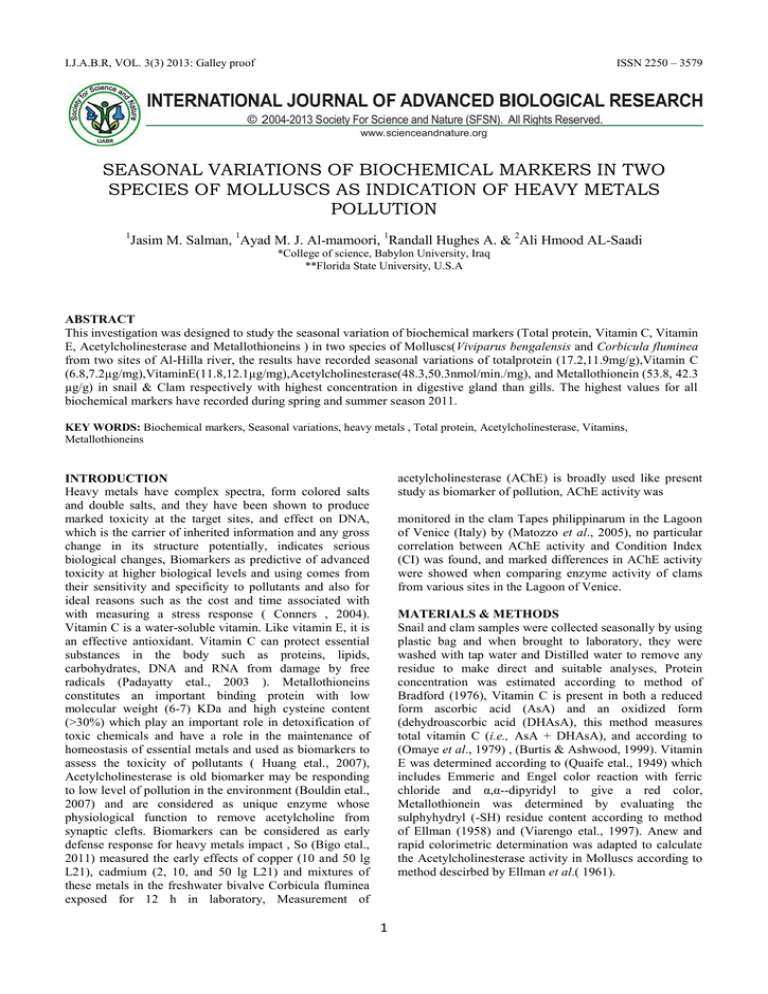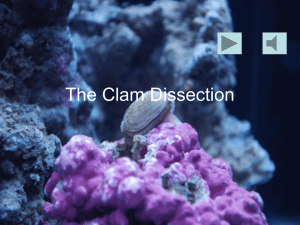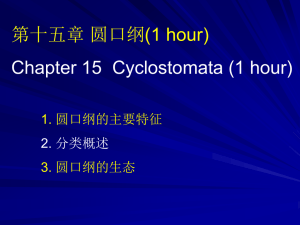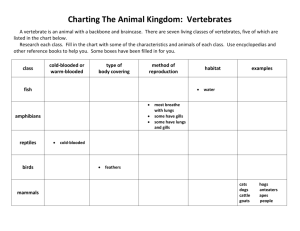SEASONAL VARIATIONS OF BIOCHEMICAL MARKERS IN TWO Jasim M. Salman,
advertisement

ISSN 2250 – 3579 I.J.A.B.R, VOL. 3(3) 2013: Galley proof SEASONAL VARIATIONS OF BIOCHEMICAL MARKERS IN TWO SPECIES OF MOLLUSCS AS INDICATION OF HEAVY METALS POLLUTION 1 Jasim M. Salman, 1Ayad M. J. Al-mamoori, 1Randall Hughes A. & 2Ali Hmood AL-Saadi *College of science, Babylon University, Iraq **Florida State University, U.S.A ABSTRACT This investigation was designed to study the seasonal variation of biochemical markers (Total protein, Vitamin C, Vitamin E, Acetylcholinesterase and Metallothioneins ) in two species of Molluscs(Viviparus bengalensis and Corbicula fluminea from two sites of Al-Hilla river, the results have recorded seasonal variations of totalprotein (17.2,11.9mg/g),Vitamin C (6.8,7.2µg/mg),VitaminE(11.8,12.1µg/mg),Acetylcholinesterase(48.3,50.3nmol/min./mg), and Metallothionein (53.8, 42.3 µg/g) in snail & Clam respectively with highest concentration in digestive gland than gills. The highest values for all biochemical markers have recorded during spring and summer season 2011. KEY WORDS: Biochemical markers, Seasonal variations, heavy metals , Total protein, Acetylcholinesterase, Vitamins, Metallothioneins acetylcholinesterase (AChE) is broadly used like present study as biomarker of pollution, AChE activity was INTRODUCTION Heavy metals have complex spectra, form colored salts and double salts, and they have been shown to produce marked toxicity at the target sites, and effect on DNA, which is the carrier of inherited information and any gross change in its structure potentially, indicates serious biological changes, Biomarkers as predictive of advanced toxicity at higher biological levels and using comes from their sensitivity and specificity to pollutants and also for ideal reasons such as the cost and time associated with with measuring a stress response ( Conners , 2004). Vitamin C is a water-soluble vitamin. Like vitamin E, it is an effective antioxidant. Vitamin C can protect essential substances in the body such as proteins, lipids, carbohydrates, DNA and RNA from damage by free radicals (Padayatty etal., 2003 ). Metallothioneins constitutes an important binding protein with low molecular weight (6-7) KDa and high cysteine content (>30%) which play an important role in detoxification of toxic chemicals and have a role in the maintenance of homeostasis of essential metals and used as biomarkers to assess the toxicity of pollutants ( Huang etal., 2007), Acetylcholinesterase is old biomarker may be responding to low level of pollution in the environment (Bouldin etal., 2007) and are considered as unique enzyme whose physiological function to remove acetylcholine from synaptic clefts. Biomarkers can be considered as early defense response for heavy metals impact , So (Bigo etal., 2011) measured the early effects of copper (10 and 50 lg L21), cadmium (2, 10, and 50 lg L21) and mixtures of these metals in the freshwater bivalve Corbicula fluminea exposed for 12 h in laboratory, Measurement of monitored in the clam Tapes philippinarum in the Lagoon of Venice (Italy) by (Matozzo et al., 2005), no particular correlation between AChE activity and Condition Index (CI) was found, and marked differences in AChE activity were showed when comparing enzyme activity of clams from various sites in the Lagoon of Venice. MATERIALS & METHODS Snail and clam samples were collected seasonally by using plastic bag and when brought to laboratory, they were washed with tap water and Distilled water to remove any residue to make direct and suitable analyses, Protein concentration was estimated according to method of Bradford (1976), Vitamin C is present in both a reduced form ascorbic acid (AsA) and an oxidized form (dehydroascorbic acid (DHAsA), this method measures total vitamin C (i.e., AsA + DHAsA), and according to (Omaye et al., 1979) , (Burtis & Ashwood, 1999). Vitamin E was determined according to (Quaife etal., 1949) which includes Emmerie and Engel color reaction with ferric chloride and α,α--dipyridyl to give a red color, Metallothionein was determined by evaluating the sulphyhydryl (-SH) residue content according to method of Ellman (1958) and (Viarengo etal., 1997). Anew and rapid colorimetric determination was adapted to calculate the Acetylcholinesterase activity in Molluscs according to method descirbed by Ellman et al.( 1961). 1 Biochemical markers in two species of molluscs as indication of heavy metals pollution site 2 and the lowest value in gills (5.6 µg/mg) in site 1 during winter while for digestive gland, Metallthionein values in gills of snail Sp. ranged (26.8-42.1 µg/g), (25.651.2 µg/g) in site 1& site2 during winter&summer respectively. Acetylcholinesteras activity concentration in gills represented with a highest value (3.84 nmol/min./mg) in site 2 during winter, and lowest value (20.1 nmol/min./mg) in site1 during summer(Table 1, Fig.1.2.5). RESULTS Total protein values in gills of snail ranged between (2.96.2mg/g) (14.7-16.2 mg/g) in site 1 during autumn2011&winter 2012 and winter & spring in both gills and digestive gland respectively.non enzymatic antioxidants (Vitamin C&Vitamin E) had been measured seasonally , vitamin C has values ranged(1.6-4.5µg/mg) in site 1 during winter & summer in gills , Vitamin E values have a highest value (10.6 µg/mg) in gills during winter in TABLE 1: Seasonal variations of biochemical markers Concentrations in Snail Viviaparus bengalensis [gills &digestive gland (d.g.)] in site 1 & site 2 of study area (Mean±S.D). Sites Season T. protein (mg/g) gill Vit. C (µg/mg)gill Vit. E (µg/mg)gill MT. (µg/g) gill ACH.gill (nmol/min./mg) T. protein (mg/g) d.g. Vit. C (µg/mg) d.g Vit. E (µg/mg) d.g MT. (µg/g) d.g. S.1 Sum. 2011 7.8 4.1 ± ± 0.1 0.06 2.6 4.5 ± ± 0.1 0.1 6.6 8.4 ± ± 0.1 0.1 38.1 42.1 ± ± 1.01 0.01 40.3 20.1 ± ± 0.1 0.01 16.2 15.8 ± ± 0.1 0.01 4.4 4.2 ± ± 0.2 0.01 9.4 9.3 ± ± 0.1 0.01 48.9 53.8 ± ± 0.01 0.1 SP. Aut. Wint. 2012 2.9 6.2 ± ± 0.01 0.02 3.6 1.6 ± ± 0.3 0.16 7.5 5.6 ± ± 0.02 0.1 32.6 26.8 ± ± 1.05 0.01 30.4 20.8 ± ± 0.01 0.1 15.4 14.7 ± ± 0.06 0.1 2.5 6.8 ± ± 0.1 0.11 7.5 11.8 ± ± 0.1 0.2 44.8 42.5 ± ± 0.1 0.001 S.2 Sum. 2011 6.1 4.3 ± ± 0.1 0.01 3.8 3.7 ± ± 0.152 0.01 7.8 7.7 ± ± 0.01 0.10 30.3 51.2 ± ± 0.1 0.11 20.9 20.6 ± ± 0.01 0.1 11.8 12.8 ± ± 0.1 0.10 3.9 5.5 ± ± 0.01 0.1 8.9 11.5 ± ± 0.01 0.1 46.1 48.8 ± ± 0. 06 0.1 SP. Aut. Wint. 2012 2.9 9.3 ± ± 0.02 0.01 2.1 6.7 ± ± 0.01 0.1 6.13 10.6 ± ± 0.06 0.1 27.9 25.6 ± ± 0.01 0.1 40.1 3.84 ± ± 0.01 0.11 17.2 11.7 ± ± 0.2 0.1 5.8 6.2 ± ± 0.1 0.21 10.8 11.6 ± ± 0.1 0.11 36.8 37.8 ± ± 0.1 0.3 Control 15 ± 0.01 7.2 ± 0.1 11.6 ± 0.1 22.5 ± 0.1 55.1 ± 0.01 25.3 ± 0.1 6.9 ± 0.01 12.5 ± 0.1 31.5 ± 0.1 p≤0.05 FIGURE 1: Seasonal variations of Biochemical markers in Snail (gill) in site 1&site2 of study area 2 FIGURE 2: Seasonal variations of Biochemical markers in Snail (d.g) in site 1&site2 of study area Biochemical markers in two species of molluscs as indication of heavy metals pollution In clam Sp., additional biochemical markers exhibited different seasonal variations. Total protein values in gills ranged between (5.8-9.5mg/g)(7.6-10.2 mg/g) in site 1 both gills and digestive gland respectively. Vitamin C has values ranged(1.9-4µg/mg) in site 1 during autumn&summer in gills , and (1.6-4.7 µg/mg) in site 2 during autumn&spring in gills. Vitamin E values had a highest value (8.7 µg/mg) in gills during spring in site 2.Metallthionein values in gills ranged from (26.8-41.9 µg/g), (20.1-32.6 µg/g) in site 1& site2 during spring,summer,.Acetylcholinesteras activity concentration in gills represented with a highest value ( 30.4 nmol/min./mg) in site 1 during spring, and lowest value (20.8 nmol/min./mg) in site1 during summer(Table 2, Fig.3,4,6) TABLE 2: Seasonal variations of biochemical markers Concentrations in Clam Corbicula fluminea [gills &digestive gland (d.g.)] in site 1 & site 2 of study area (Mean±S.D). Sites Season T. protein (mg/g) gill Vit. C (µg/mg)gill Vit. E (µg/mg)gill MT. (µg/g) gill ACH.gill (nmol/min./mg) T. protein (mg/g) d.g. Vit. C (µg/mg) d.g Vit. E (µg/mg) d.g MT. (µg/g) d.g. SP. 2011 8.5 ± 0.1 2.1 ± 0.01 6.1 ± 0.1 26.8 ± 0.1 40.3 ± 0.1 11.8 ± 0.1 2.6 ± 0.1 7.6 ± 0.1 26.9 ± 0.01 S.1 Sum. 7.2 ± 0.01 4 ± 1.1 7.2 ± 0.01 41.9 ± 0.01 20.8 ± 0.01 9.1 ± 0.01 6.8 ± 0.12 10.8 ± 0.1 42.3 ± 0.01 Aut. 2012 9.5 ± 0.1 1.9 ± 0.1 4.8 ± 0.1 39.5 ± 0.1 30.2 ± 0.1 11.9 ± 0.1 5.4 ± 0.2 10.3 ± 0.22 26.8 ± 0.1 Wint. 5.8 ± 0.2 3.5 ± 0.02 8.2 ± 0.2 34.9 ± 0.02 30.6 ± 0.33 10.8 ± 0.11 5.2 ± 0.01 10.2 ± 0.1 30.3 ± 0.11 SP. 2011 5.2 ± 0.10 4.7 ± 0.1 8.7 ± 0.1 27.9 ± 0.01 30.4 ± 0.2 9.6 ± 0.1 6.8 ± 0.1 11.8 ± 0.10 33.5 ± 0.1 S.2 Sum. 5.3 ± 0.01 4.2 ± 0.01 8.2 ± 0.01 32.6 ± 0.1 20.9 ± 0.001 5.8 ± 0.01 6.5 ± 0.1 11.4 ± 0.001 36.8 ± 0.1 Aut. 2012 3.1 ± 0.1 1.6 ± 0.1 5.6 ± 0.2 21.3 ± 0.1 50.3 ± 0.1 5.4 ± 0.1 7.2 ± 0.001 12.1 ± 0.1 26.6 ± 0.001 Wint. Control 2.9 ± 0.01 1.8 ± 0.1 5.8 ± 0.01 20.1 ± 0.001 50.2 ± 0.01 10.8 ± 0.11 5.7 ± 0.12 10.7 ± 0.1 27.9 ± 0.01 13.8 ± 0.2 5.6 ± 0.01 9.4 ± 0.11 18.1 ± 0.2 59.1 ± 0.01 16.5 ± 0.1 7.3 ± 0.2 12.9 ± 0.01 22.3 ± 0.01 p≤0.05 FIGURE 3: Seasonal variations of Biochemical markers in Clam (gill) in site 1&site2 of study area 2 FIGURE 4: Seasonal variations of Biochemical markers in Clam (d.g) in site 1&site2 of study area Biochemical markers in two species of molluscs as indication of heavy metals pollution FIGURE 5: Seasonal variations of Acetylcholinesterase in Snail (gill) in site 1&site2 of study area FIGURE 6: Seasonal variations of Acetylcholinesterase in Clam (gill) in site 1&site2 of study area 2004), the highest values of biochemical recorded in digestive gland due to their importance in metals detoxification and metabolism which considered as longterm storage tissue DISCUSSION Biochemical responses as an important tool for detection the impact of heavy metals pollutants were taken into account by many studies such as (Regoli etal., 1998), The fluctuation in biomarker responses in this study because these responses are transient and variable according to the different species and pollutants (An etal., 2012). The highest concentration of different biomarkers in warm season and summer have been agreed with (Barreira etal., 2006) due to Increases in water temperature may enhance accumulation and toxicity of contaminants, the inhibition of acetylcholinesterase activity with increased level of Metallothionein in molluscs during study period in comparison to control in coincided with many studies such as (Lionetto etal., 2003) , all results have indicated the high response of metallothionein according to heavy metals concentration like (Lafontaine etal., 2000) study on zebra mussels (Dreissena polymorpha) which their results showed that MT. exhibited the highest correlation coefficients with heavy metals, elevation of metallothioneins concentration during summer in this study have been agreed with many research such as (Zorita etal., 2007). The reduction in acetylcholinestrase activity through study period seasonally due to sediment mobilization caused by clam harvesting plays an important role in resuspension of persistent contaminants having neurotoxic activity (Matozzo etal., 2005), also the inhibition of acetylcholinesterase activity as response of heavy metals aligned with many study such as (Monserrat etal., 2002), moreover, Because of its participation in neurotransmission, AChE is adapted highly sensitive to biotic and abiotic parameters (Banni etal., 2010), Non significance correlation in some times in this study between heavy metals and biomarkers may be due to the fact that metals didn't approach threshold to induce these biomarkers, or the biomarkers didn't response specifically to these heavy metals, or even that other factors can be affecting the biomarkers variability, Previous studies confirmed that biomarkers can be influenced by seasonal parameters as in this study which including temperature, gametogenesis, salinity, nutrition, starvation, and light penetration in addition to seasonal effects (Shaw etal., CONCLUSION We concluded that Seasons and environmental parameters have an important role in different biomarker responses against heavy metals, and Increasing or decreasing the biomarkers in this study due to oxidative stress induced by heavy metals which lead to increase ROS (Reactive oxygen species). REFERENCES An, L.; Zheng, B.; Wang, L.; Zhang,Y; Chen,H.; Zhao, X.; Zhang, L. & Lei, K.(2012) Biomarker responses and genotoxicity in the mud snail (Bullacta exarata) as indicators of coastal contamination. Marine Pollution Bulletin, 64: 303–309. Conners, D. E. ( 2004) Biomarkes of oxidative stress in fresh water clam (Corbicula Fluminea)as mechanistic tool to evaluate the impairment of stream ecosystem health by lawn care pesticides .Ph.D thesis, The University of Georgia ,U.S.A. Banni, M.; Negri, A.; Dagnino, A.; Jebali, J.; Ameur, S.& Boussetta, H. (2010) Acute effect sofbenzo[a] pyreneon digestive gland enzymatic biomarkers and DNA damageonmussel Mytilus galloprovincialis. Ecotoxicology and Environmental Safety 73: 842–848. Barreira, L.A.; Mudge, S.M. & Bebianno, M. J. (2006) Oxidative Stress in the Clam Ruditapes decussatus (Linnaeus, 1758) in Relation to Polycyclic Aromatic Hydrocarbon Body Burden. Environ. Toxicol., 22: 203– 221 . Bigot, A.; Minguez, L.; Giambe' rini, L. & Rodius, F. (2011) Early Defense Responses in the Freshwater Bivalve Corbicula fluminea Exposed to Copper and Cadmium: 4 ISSN 2250 – 3579 I.J.A.B.R, VOL. 3(3) 2013: Galley proof Transcriptional and Histochemical Studies. Environ Toxicol 26: 623–632. from the Lagoon of Venice. Marine Pollution Bulletin 50: 1686–1693. Bouldin, J.; Farris, J.L.; Moor, M.T.; Smith, J.R.S.& Cooper, C. M. (2007) Assessment of Diazinon Toxicity in Sediment and Water of Constructed Wetlands Using Deployed Corbicula fluminea and Laboratory Testing. Arch Environ Contam Toxicol, 53(2):174-82 Monserrat, J.M.; Bianchini, A.& Bainy, A.C.D.(2002) Kinetic and toxicological characteristics of acetylcholinesterase from the gills of oysters (Crassostrea rhizophorae) and other aquatic species. Marine Environmental Research ,54: 781–785. Bradford, M. M. (1976) A rapid and sensitive method for the quantitation of microgram quantities of protein utilizing the principle of protein-dye binding. Analyt Biochem ,72: 248–254. Quaife, M.L.; Scrimshaw, N.S. & Lowry, O. H. ( 1949) A micro method for assay of total tocopherols in blood serum. J Biol. Chem., 180:1229–1235. Omaye, S.T.; Turnbull, D. J. & Sauberlich, H.E. (1979) Selected methods for the determination of ascorbic acid in animal cells, tissues and fluids. Methods Enzymol, 62, 3– 11. Burtis, C.A. and Ashwood E. R. (1999) Tietz Textbook of Clinical Chemistry, 3rd ed., Philadelphia, W.B.Saunders Co. Ellman, G.L.(1958) A colorimetric method for determining low concentrations of mercaptans.Archives of biochemistry and Biophysics 74,443-450. Padayatty, S.J.; Wang, , Y.; Kwon, O.; Lee, J.; Chen, Sh.; Corpe, Ch.; Dutta, A.; Dutta, S.K.& Levine, M. (2003) Vitamin C as an Antioxidant: Evaluation of Its Role in Disease Prevention(Review). Journal of the American College of Nutrition, 22(1): 18-35. Ellman, G. L., Courtney, K. D., Andres, V., Jr. & Featherstone, R. M. (1961) A new and rapid colorimetricdetermination of acetylcholinesterase activity, Biochem. Pharmacol. ,7, 88–95. Regoli, F.; Winston, G. W; Mastrangelo, V.; principato, G.& Bompadre, S. (1998) Total oxyradical Scavenging capacity in Mussel Mytilus Sp.as a newindexof biological resistance to oxidative stress.Chemosphere,37(14-15): 2773-2783. Huang,Z.;Zhang,Q.;Chen,J.;Zhuang,Z.&Wang,X.(2007) Bioaccumulation of metals and induction of Metallothioneins in selected tissues of common carp (Cyprinus carpio L.) co-exposed to cadmium, mercury and lead. Applied Organometallic Chemistry, 21(2):101-107. Shaw, J. P.; Large, A.T.; Chipman, J. K.; Livingstone, D. R.& Peters, L. D. (2004) Seasonal variation in mussel Mytilus edulis digestive gland cytochrome P4501A- and 2E-immunoidentified protein levels and DNA strand breaks (Comet assay). Marine Environmental Research 50: 405-409. Lafontaine,Y.D.; Gagne´, F.; Blaise, Ch.; Costan, G.; Gagnon, P.& Chan, H.M.(2000) Biomarkers in zebra mussels (Dreissena polymorpha) for the assessment and monitoring of water quality of the St Lawrence River (Canada). Aquatic Toxicology, 50: 51–71. Zorita, I.; Apraiz, I.; Ortiz-Zarragoitia, M.; Ibon Cancio, A.O; Soto, M.; Marigo´mez, I.; Cajaraville, M.P. ( 2007) Assessment of biological effects of environmental pollution along the NW Mediterranean Sea using mussels as sentinel organisms. Environmental Pollution 148: 236e250. Lionetto,M.G.; Caricato, R.; Giordano, M.E.; Pascariello, M.F.; Marinosci, L.& Schettino, T.(2003) Integrated use of biomarkers (acetylcholinesterase and antioxidant enzymes activities) in Mytilus galloprovincialis and Mullus barbatus in an Italian coastal marine area. Marine Pollution Bulletin ,46: 324–330. Matozzo, V.; Tomei, A. & Marin, M. G. (2005) Acetylcholinesterase as a biomarker of exposure to neurotoxic compounds in the clam Tapes philippinarum 5




